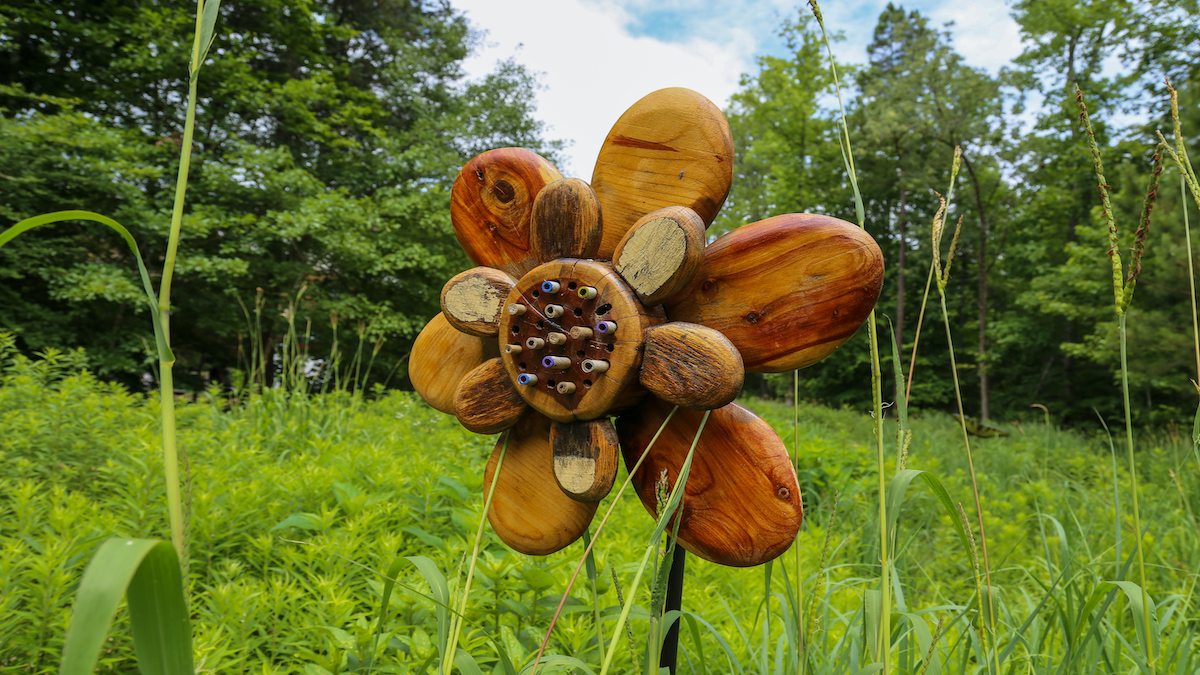North Carolina Botanical Garden’s bee hotels
Located just off main campus, the North Carolina Botanical Garden has been caring for pollinators with bee hotels. The structures, designed by artist David Hinkle, are meant to help native bees nest and reproduce.

The world needs bees.
From native bees to honeybees, the insects play an instrumental role in pollinating flowering plants. As Johnny Randall, director of conservation programs at the North Carolina Botanical Garden, puts it, “Without native bees, there are no blueberries.”
If that seems like a dire warning, it should be. According to the USDA, bees are responsible for pollinating 75% of plant life in the U.S. Although honeybees have grown in popularity, it’s native bees that are doing most of the heavy lifting, pollinating staple crops like potatoes, squash, eggplant and watermelon, as well as other plants native to the U.S.
The ongoing decline in native bees, alongside the decreasing honeybee population, could dramatically shift food supplies in the future.
Conservation efforts at the North Carolina Botanical Garden are focused on helping reverse those trends. “We’re always thinking about pollinators as an important resource,” Randall explains. “For example, we ensure that there’s bare ground in our nature preserve. Maybe 70% of bees nest in the ground, and they need sites where bare ground is available for them to burrow so they don’t burrow through lots of dirt.”
As part of their conservation endeavors, the North Carolina Botanical Garden has installed a new bee hotel sculpture called “The Big Bumble” to provide needed refuge for pollinators. Designed and built by local artist David Hinkle, the handmade wooden sculpture was first displayed as part of the “Sculpture in the Garden” exhibit last fall and now sits in the Children’s Wonder Garden.
The bee hotels combine aesthetics with purpose. As bees’ natural habitats — bare ground and tree cavities — disappear, bee hotels offer them a place to nest and reproduce. Many bees are solitary and need these spaces to sustain their numbers.
“You provide a tube, then the bees go in there, lay their eggs, and put up a partition,” says Hinkle. Mason bees use mud, whereas leafcutting bees use leaves. “In the fall, there will be a cocoon with a bee in it, they winter in here, and then they come out in the spring. That’s what a bee hotel is all about.”
Hinkle built his first bee hotel in 2017 as part of a commission for the Town of Hillsborough through the Orange County Arts Commission. During that project, he realized how much people didn’t know about native bee habitats and often found himself playing teacher.
“I talked to literally hundreds of people while putting that thing up, and I bet you 90 to 95% of people didn’t know what a bee hotel was for,” he says. “Most of those bees don’t live in hives but prefer underground nests or cavities. Nobody knows about it.”
Beyond providing bees with cavities to use as nests, bee hotels also bring that education to the North Carolina Botanical Garden’s visitors. “Bee hotels demonstrate to the public that there are all these different solitary bees, and they need cavities to nest in,” says Randall.
“I hope [visitors] learn that solitary bees are so tame,” he adds. “They would never sting anyone unless you tried to grab one and hold it in your hand and crush it. They’re not like wasps. Wasps are mean. Bees are friendly.”
Although Hinkle didn’t intend to focus on bees as a design-builder, he’s embraced his work on bee hotels and hopes they can be used alongside other projects to inform the public about the importance of native bees. “It seems like bee hotels could provide a great opportunity for education and awareness, and getting people involved and learning about it,” he says.





